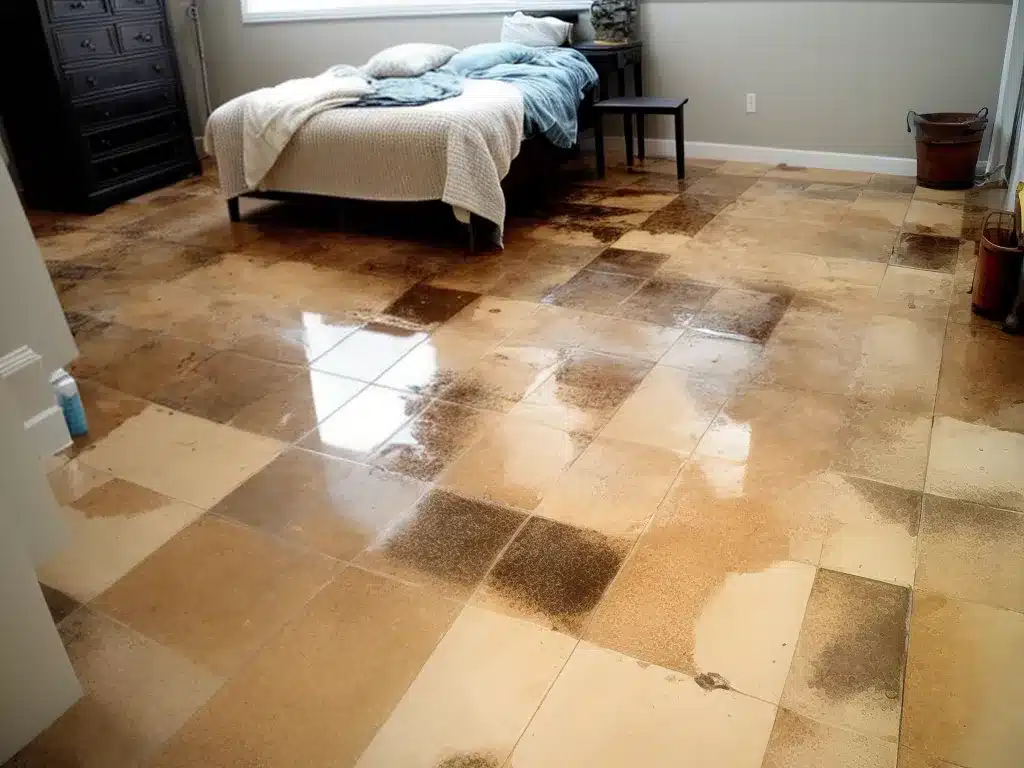Assess the Damage
Before attempting to restore your floors, it’s important to fully assess the current condition. This will help you understand what needs to be done and equip you with the right information to get your floors back to their former glory.
-
Take stock of visible stains or damage. Get down on your hands and knees and inspect every inch of the floor. Make note of any stains, scuffs, scratches, discoloration or other issues. Pay close attention along high traffic areas and edges.
-
Consider the floor type. Hardwood, laminate, tile, and vinyl floors all have different cleaning needs. Identify your floor type so you can use appropriate methods and products.
-
Determine the finish. Does your hardwood or laminate floor have a wax, polyurethane or oil finish? This impacts your ability to refinish the floors. Test inconspicuous areas with water to see if it beads up (wax) or soaks in (oil).
-
Assess wear patterns. Check if there are uneven worn areas, which may need special attention. High traffic lanes around furniture may require extra scrubbing.
Thoroughly evaluating the current condition of your floors ensures you go into the restoration process fully prepared.
Deep Cleaning filthy Floors
Now that you’ve assessed the floor damage and identified the floor type, it’s time for a deep clean. This prepares floors for restoration by removing built-up grime.
Supplies Needed
- Mop bucket with detachable mop head
- Microfiber mops and cloths
- Broom and dustpan
- Vacuum
- Floor cleaner and degreaser
- Scrub brush/pad for tougher stains
- Terry cloth towels
- Rubber gloves
Step-by-Step Process
- Sweep floors thoroughly to remove loose debris and dirt. Vacuum if needed.
- Fill mop bucket with hot water and add floor cleaner as directed. For heavier grime, use a degreaser.
- Working in sections, mop floors using overlapping strokes. Change rinse water frequently.
- Use scrub brush and concentrated cleaner to tackle tougher stains. Rinse thoroughly.
- Follow up with microfiber mop to remove any haze and pick up excess moisture.
- Allow floors to fully dry before moving on to refinishing.
Deep cleaning removes years of built-up dirt, stains and residue to reveal the floor’s true surface. Proper products and technique ensure floors are prepped for refinishing.
Refinishing Options by Floor Type
Once floors are deep cleaned, the refinishing process can begin. Available options vary depending on your specific floor type.
Hardwood Floors
Screen and recoat – Lightly abrade surface and apply new protective coat of polyurethane. Ideal for minor scratches and wear.
Sand and refinish – Sand floors down to bare wood and apply stain and protective coats. Best for extensive damage.
Spot repair – Use fillers on isolated scratches and dents before recoating. Good for minor issues.
Laminate Floors
Damp mop – Mix vinegar and water solution to remove smudges and enhance shine.
Repair kits – Use filler putty for chips and planks to replace damaged boards.
Buffing – Use buffer machine with non-abrasive pad to restore luster.
Tile Floors
Scrubbing – Scrub with brush and alkaline tile cleaner to remove stains and discoloration.
Re-grouting – Remove old grout and reapply new grout lines for clean look.
Sealing – Seal grout and tile surface to protect from future stains.
Vinyl Floors
Strip and wax – Chemical stripper removes buildup so new wax can be applied.
Buffing – Use buffer and non-abrasive pad to remove scuffs and enhance shine.
Vinyl restoration kits – Products are available to patch and seal damaged vinyl flooring.
The best refinishing method depends on your specific floor type and condition. Seek professional help for extensive hardwood refinishing or tile regrouting projects.
Maintaining the Renewed Floors
Restored floors look fantastic but require maintenance to keep them that way. Here are some tips:
- Sweep, dust mop and vacuum regularly to prevent dirt buildup.
- Add floor protector pads on furniture legs to prevent scratching.
- Wipe spills immediately to prevent staining.
- Avoid excessive water and harsh cleaners which can damage floors.
- Refrain from wearing shoes inside the house to minimize dirt tracked in.
- Follow any specific product instructions for maintaining your floor finish.
- Consider having professionals periodically buff, recoat or reseal floors.
With consistent care and maintenance, you can keep your renewed floors looking pristine for years to come! Proper assessment, deep cleaning methods and refinishing techniques can restore filthy floors back to their former glory.







